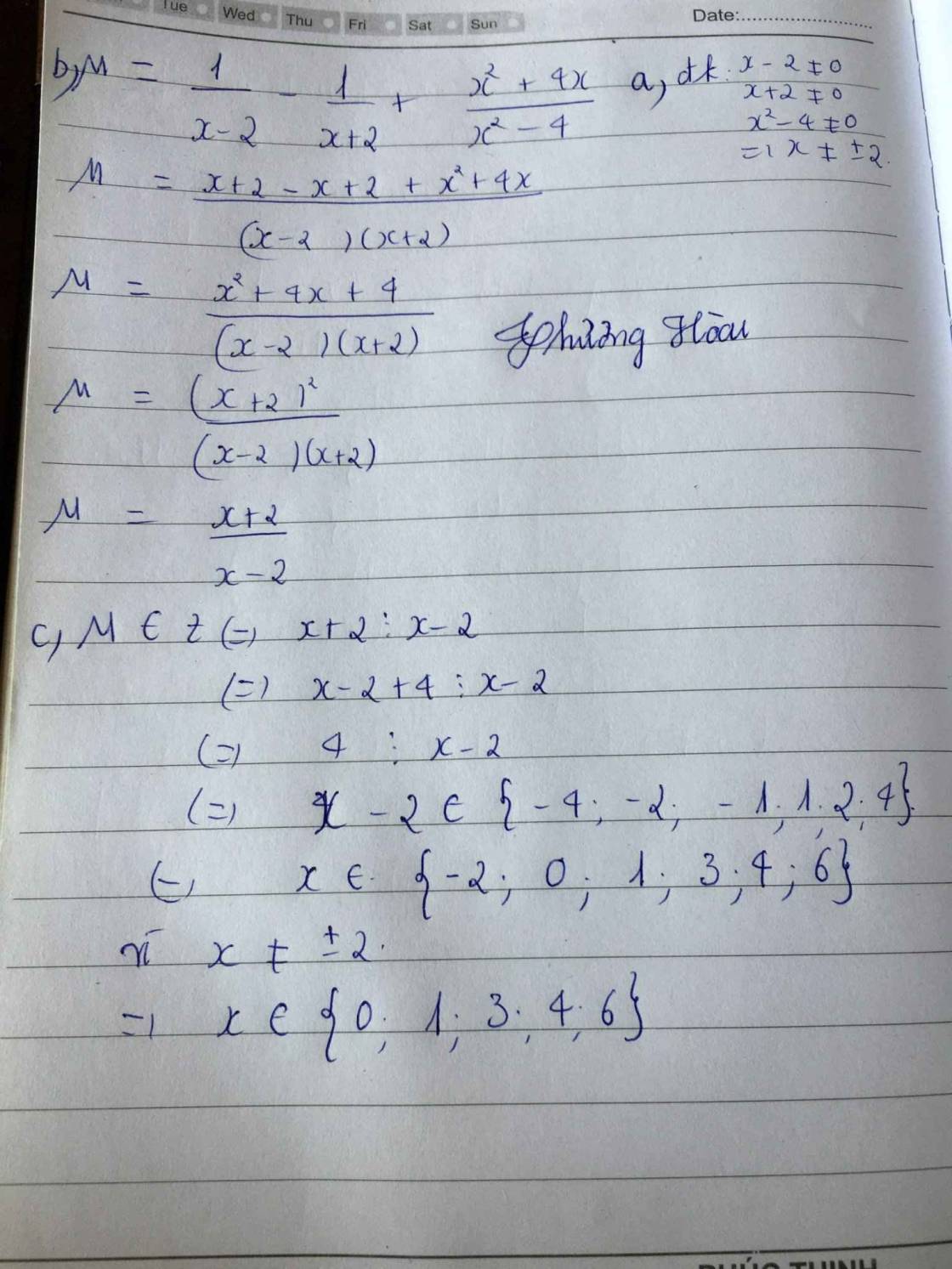Hãy nhập câu hỏi của bạn vào đây, nếu là tài khoản VIP, bạn sẽ được ưu tiên trả lời.

a: ĐKXĐ: x<>0; x<>5; x<>5/2; x<>-5
b: \(M=\left(\dfrac{x}{\left(x-5\right)\left(x+5\right)}-\dfrac{x-5}{x\left(x+5\right)}\right):\dfrac{2x-5}{x\left(x+5\right)}\)
\(=\dfrac{x^2-x^2+10x-25}{x\left(x-5\right)\left(x+5\right)}\cdot\dfrac{x\left(x+5\right)}{2x-5}=\dfrac{1}{x-5}\)

a) \(M=\frac{x^4+2}{x^6+1}+\frac{x^2-1}{x^4-x^2+1}+\frac{x^2+3}{x^4+4x^2+3}\)
\(M=\frac{x^4+2}{\left(x^2+1\right)\left(x^4-x^2+1\right)}+\frac{x^2-1}{x^4-x^2+1}-\frac{x^2+3}{x^4+3x^2+x^2+3}\)
\(M=\frac{x^4+2}{\left(x^2+1\right)\left(x^4-x^2+1\right)}+\frac{x^2-1}{x^4-x^2+1}-\frac{x^2+3}{x^2\left(x^2+3\right)+x^2+3}\)
\(M=\frac{x^4+2}{\left(x^2+1\right)\left(x^4-x^2+1\right)}+\frac{x^2-1}{x^4-x^2+1}-\frac{x^2+3}{\left(x^2+3\right)\left(x^2+1\right)}\)
\(M=\frac{x^4+2}{\left(x^2+1\right)\left(x^4-x^2+1\right)}+\frac{x^2-1}{x^4-x^2+1}-\frac{1}{x^2+1}\)
\(M=\frac{x^4+2+x^4-1-x^4+x^2-1}{\left(x^2+1\right)\left(x^4-x^2+1\right)}\)
\(M=\frac{0+x^4+x^2}{\left(x^2+1\right)\left(x^4-x^2+1\right)}\)
\(M=\frac{x^2\left(x^2+1\right)}{\left(x^2+1\right)\left(x^4-x^2+1\right)}\)
\(M=\frac{x^2}{x^4-x^2+1}\)

a)
\(ĐKXĐ:\left\{{}\begin{matrix}x-2\ne0\\x+2\ne0\\x^2-4\ne0\end{matrix}\right.< =>\left\{{}\begin{matrix}x\ne2\\x\ne-2\end{matrix}\right.\)
b)
\(\dfrac{1}{x-2}-\dfrac{1}{x+2}+\dfrac{x^2+4x}{x^2-4}\)
\(=\dfrac{1}{x-2}-\dfrac{1}{x+2}+\dfrac{x\left(x+4\right)}{\left(x-2\right)\left(x+2\right)}\)
\(=\dfrac{x+2}{\left(x-2\right)\left(x+2\right)}-\dfrac{x-2}{\left(x-2\right)\left(x+2\right)}+\dfrac{x\left(x+4\right)}{\left(x-2\right)\left(x+2\right)}\)
\(=\dfrac{x+2-x+2+x^2+4x}{\left(x-2\right)\left(x+2\right)}\)
\(=\dfrac{x^2+4x+4}{\left(x-2\right)\left(x+2\right)}\\ =\dfrac{\left(x+2\right)^2}{\left(x-2\right)\left(x+2\right)}\\ =\dfrac{x+2}{x-2}\)
c)
\(\dfrac{x+2}{x-2}=\dfrac{x-2+4}{x-2}=\dfrac{x-2}{x-2}+\dfrac{4}{x-2}=1+\dfrac{4}{x-2}\)
vậy M nhận giá trị nguyên thì 4⋮x-2
=> x-2 thuộc ước của 4
\(Ư\left(4\right)\in\left\{-1;1;-2;2;;4;-4\right\}\)
ta có bảng sau
| x-2 | -1 | 1 | -2 | 2 | 4 | -4 |
| x | 1(tm) | 3(tm) | 0(tm) | 4(tm) | 6(tm | -2(loại) |

a) Phân thức M xác định khi :
+) \(x\ne0\)
+) \(x-2\ne0\Leftrightarrow x\ne2\)
b) \(M=\left(\frac{2}{x}-\frac{2}{x-2}\right):\frac{3x}{x-2}\)
\(M=\left(\frac{2\left(x-2\right)}{x\left(x-2\right)}-\frac{2x}{x\left(x-2\right)}\right)\cdot\frac{x-2}{3x}\)
\(M=\left(\frac{2x-4-2x}{x\left(x-2\right)}\right)\cdot\frac{x-2}{3x}\)
\(M=\frac{-4\cdot\left(x-2\right)}{x\left(x-2\right)\cdot3x}\)
\(M=\frac{-4}{3x^2}\)
c) Thay x = -2 ta có :
\(M=\frac{-4}{3\cdot\left(-2\right)^2}=\frac{-1\cdot4}{3\cdot4}=\frac{-1}{3}\)
Vậy........

a) ĐKXĐ: \(x\notin\left\{0;-5\right\}\)
Ta có: \(B=\dfrac{x^2+2x}{2x+10}+\dfrac{x-5}{x}-\dfrac{5x-50}{2x^2+10x}\)
\(=\dfrac{x^2+2x}{2\left(x+5\right)}+\dfrac{x-5}{x}-\dfrac{5x-50}{2x\left(x+5\right)}\)
\(=\dfrac{x^3+2x^2}{2x\left(x+5\right)}+\dfrac{2\left(x+5\right)\left(x-5\right)}{2x\left(x+5\right)}-\dfrac{5x-50}{2x\left(x+5\right)}\)
\(=\dfrac{x^3+2x^2+2x^2-50-5x+50}{2x\left(x+5\right)}\)
\(=\dfrac{x^3+4x^2-5x}{2x\left(x+5\right)}\)
\(=\dfrac{x\left(x^2+4x-5\right)}{2x\left(x+5\right)}\)
\(=\dfrac{x^2+5x-x-5}{2\left(x+5\right)}\)
\(=\dfrac{x\left(x+5\right)-\left(x+5\right)}{2\left(x+5\right)}\)
\(=\dfrac{\left(x+5\right)\left(x-1\right)}{2\left(x+5\right)}\)
\(=\dfrac{x-1}{2}\)
b) Để B=0 thì \(\dfrac{x-1}{2}=0\)
\(\Leftrightarrow x-1=0\)
hay x=1(nhận)
Vậy: Để B=0 thì x=1
Để \(B=\dfrac{1}{4}\) thì \(\dfrac{x-1}{2}=\dfrac{1}{4}\)
\(\Leftrightarrow4\left(x-1\right)=2\)
\(\Leftrightarrow4x-4=2\)
\(\Leftrightarrow4x=6\)
hay \(x=\dfrac{3}{2}\)(nhận)
Vậy: Để \(B=\dfrac{1}{4}\) thì \(x=\dfrac{3}{2}\)
c) Thay x=3 vào biểu thức \(B=\dfrac{x-1}{2}\), ta được:
\(B=\dfrac{3-1}{2}=\dfrac{2}{2}=1\)
Vậy: Khi x=3 thì B=1
d) Để B<0 thì \(\dfrac{x-1}{2}< 0\)
\(\Leftrightarrow x-1< 0\)
\(\Leftrightarrow x< 1\)
Kết hợp ĐKXĐ, ta được:
\(\left\{{}\begin{matrix}x< 1\\x\notin\left\{0;-5\right\}\end{matrix}\right.\)
Vậy: Để B<0 thì \(\left\{{}\begin{matrix}x< 1\\x\notin\left\{0;-5\right\}\end{matrix}\right.\)
Để B>0 thì \(\dfrac{x-1}{2}>0\)
\(\Leftrightarrow x-1>0\)
hay x>1
Kết hợp ĐKXĐ, ta được: x>1
Vậy: Để B>0 thì x>1

\(M=\dfrac{4}{x+2}+\dfrac{3}{x-2}-\dfrac{5x+2}{x^2-4}\left(dkxd:x\ne\pm2\right)\)
\(=\dfrac{4}{x+2}+\dfrac{3}{x-2}-\dfrac{5x+2}{\left(x-2\right)\left(x+2\right)}\)
\(=\dfrac{4\left(x-2\right)+3\left(x+2\right)-\left(5x+2\right)}{\left(x-2\right)\left(x+2\right)}\)
\(=\dfrac{4x-8+3x+6-5x-2}{\left(x-2\right)\left(x+2\right)}\)
\(=\dfrac{2x-4}{\left(x-2\right)\left(x+2\right)}\)
\(=\dfrac{2\left(x-2\right)}{\left(x-2\right)\left(x+2\right)}\)
\(=\dfrac{2}{x+2}\)
Để \(M=\dfrac{2}{5}\) thì \(\dfrac{2}{x+2}=\dfrac{2}{5}\)
Suy ra :
\(2.5=2\left(x+2\right)\)
\(\Leftrightarrow2x+4=10\)
\(\Leftrightarrow x=3\)
Vậy \(M=\dfrac{2}{5}\) thì x = 3